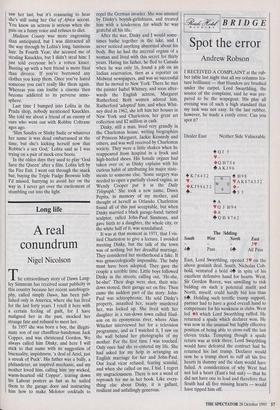Long life
A real conundrum
Nigel Nicolson
The extraordinary story of Dawn Lang- ley Simmons has received scant publicity in this country because her recent autobiogra- phy, called simply Dawn, has been pub- lished only in America, where she has lived for the last forty years. I retell it here with a certain feeling of guilt, for I have maligned her in the past, mocked her strange fate and refused to meet her.
In 1937 she was born a boy, the illegiti- mate son of our chauffeur-handyman Jack Copper, and was christened Gordon. We always called him Dinky, and here I will stick to that name with its suggestion of bisexuality, impishness, 'a deal of Ariel, just a streak of Puck'. His father was a bully, a philanderer, an inspired mechanic, and my mother loved him, calling him 'my wicked, warm-hearted old Copper', tearing down his Labour posters as fast as he nailed them to the garage door and instructing him how to make Molotov cocktails to repel the German invader. She was amused by Dinky's boyish-girlishness, and treated him with a tenderness for which he was grateful all his life.
After the war, Dinky and I would some- times bathe together in the lake, and I never noticed anything abnormal about his body. But he had the internal organs of a woman and lived with this secret for thirty years. Hating his father, he fled to Canada when he was only 16, found a job on an Indian reservation, then as a reporter on Midwest newspapers, and was so successful that he moved to New York. There he met the painter Isabel Whitney, and soon after- wards the English actress, Margaret Rutherford. Both women adored him. Rutherford 'adopted' him, and when Whit- ney died in 1962, she left him her houses in New York and Charleston, her great art collection and 52 million in cash.
Dinky, still a man, lived very grandly in the Charleston house, writing biographies of Princess Margaret, Jackie Kennedy and others, and was well received by Charleston society. They were a little shaken when he reappeared from hospital in a frock and high-heeled shoes. His female organs had taken over or, as Dinky explains with his curious habit of attributing his major state- ments to someone else, 'Some surgery was needed to open a partially closed vagina, as Wendy Cooper put it in the Daily Telegraph.' She took a new name, Dawn Pepita, in memory of my mother, and thought of herself as Orlando. Charleston found all of this just acceptable, but when Dinky married a black garage-hand, turned sculptor, called John-Paul Simmons, and gave birth to a daughter, the whole city, or the white half of it, was scandalised.
It was at that moment in 1971, that I vis- ited Charleston to give a lecture. I avoided meeting Dinky, but the talk of the town was of nothing but her dreadful marriage. They considered her motherhood a fake. It was gynaecologically impossible. The baby must have been adopted. They gave the couple a terrible time. Little boys followed Dinky in the streets, calling out, 'He-she, he-she!' Their dogs were shot, their win- dows stoned, their garage set on fire. Then came the saddest part of the story. John- Paul was schizophrenic. He sold Dinky's property, assaulted her, nearly murdered her, was locked up. She lived with her daughter in a run-down town called Hud- son on its eponymous river, where Alan Whicker interviewed her for a television programme, and as I watched it, I saw on the wall behind her photographs of my mother. For the first time I was touched. Only once had she re-entered my life. She had asked for my help in arranging an English marriage for her and John-Paul. Our local vicar refused, fearing scandal, and when she called on me, I hid. I regret my ungraciousness. There is not a word of reproach for me in her book. Like every- thing else about Dinky, it is gallant, resilient and unfailingly generous.


































































 Previous page
Previous page